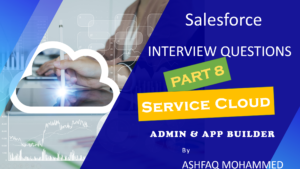Salesforce Admin Interview Questions – Environments & Deployments
ENVIRONMENTS & DEPLOYMENTS
Table of Contents
246. What are deployments in salesforce?
Answer:
Salesforce deployment is a process or activity that typically takes place at the end of development, it is the act of moving changes from one salesforce environment to another salesforce environment or production environment.
247. What is an org in salesforce?
Answer:
- An org is nothing but an identifier that represents a customer’s version of salesforce and its data within a salesforce instance. A Salesforce instance can have multiple customers orgs.
- Each org can be highly customized which includes custom objects, custom fields, apps , tabs, workflows, process builders, data sharing rules, visualforce pages , apex classes , triggers etc.
- To get the instance and Org details, goto → setup → company Information.


248. What are the two broad categories of orgs?
Answer:
- Production Org
- Development Orgs or Sandbox
249. What are different types of sandboxes in salesforce?
Answer:
- Developer Sandbox
- Developer Pro Sandbox
- Partial Copy Sandbox
- Full Copy sandbox
250. Explain the limitation of each sandbox?
Answer:
| Sandbox Type | Refresh Interval | Storage Limit | What’s Copied | Sandbox Templates |
| Developer Sandbox | 1 day | Data storage: 200 MBFile storage: 200 MB | Metadata only | Not available |
| Developer Pro Sandbox | 1 day | Data storage: 1 GBFile storage: 1 GB | Metadata only | Not available |
| Partial Copy Sandbox | 5 days | Data storage: 5 GBFile storage: Same as your production org | Metadata and sample data | Required |
| Full Sandbox | 29 days | Same as your production org | Metadata and all data | Available |
251. What is a salesforce environment?
Answer:
Salesforce environment is a salesforce org which is used for a specific purpose. Example, development , Testing or QA , staging , training and production environments.

252. How to create a salesforce sandbox?
Answer:
- When a company purchases a salesforce org they will get production org and production org will have the option to create sandboxes.
- Goto Setup → Sandboxes → new Sandbox




253. Explain what will happen once we create a sandbox?
Answer:
- All the users from production will be copied to the sandbox
- All the user username will be suffixed with .sandbox name
- Example : if sandbox name is dev1
- ashfaq.mohammed@mycompany.com.dev1
- All the email will be suffixed with .invalid
- ashfaq.mohammed@mycompany.com.invalid
- Only the metadata from production is copied to dev sandbox
- All metadata and Partial data will be copied to partial copy sandbox
- All metadata and Full data will be copied to full copy sandbox
254. How to login into a sandbox or production orgs?
Answer:
- User test.salesforce.com url to login into any sandbox
- Use login.salesforce.com url to login into production
255. What is sandbox refresh and how do we refresh sandbox?
Answer:
- Refreshing a sandbox updates its metadata from the source org. Most often the refresh is done from production org.
- If the sandbox is a clone or if it uses a sandbox template, the refresh process updates the org’s data and its metadata.
- Goto Setup → sandboxes → list of sandboxes → refresh button next to the sandbox name
256. What are different tools used for salesforce deployments?
Answer:
- Change Set
- ANT Migration tool
- Salesforce Packages (Managed and unmanaged packages)
- Salesforce DX
Third party release management tools (Paid)
- Auto Rabbit
- Copado
- Clickdeploy (acquired by Copado)
- Gearset
- Flosum
- Blue canvas
Any Salesforce IDE
- Visual Studio Code
- Eclipse Force.com IDE
- Welkin Suite – Paid
- Illuminated Cloud (IntelliJ Idea) – Paid
257. What is an outbound changeset?
Answer:
An outbound change set is a change set created in the Salesforce org in which you are logged in and that you want to send to another org.
You typically use an outbound change set for customizations created and tested in a sandbox and that are then sent to a production org.








258. What is an inbound changeset?
Answer:
- An inbound change set is a change set that has been sent from another Salesforce org to the org you are logged in to. A change set must be deployed for the changes to take effect.
- You can deploy the contents of an inbound change set as a whole but not on a component-by-component basis.
- Goto setup → Environments → Change Sets → Inbound change Set





259. Is it compulsory to do the configuration / development in a sandbox and then deploy to production? Can we do the changes directly in production?
Answer:
- There are some limitations like, apex code and triggers cannot be directly modified in production.
- While we can do any configuration changes in production it will have cascading effects. Like if we are modifying a process builder and a user is using some functionality which uses that process builder.
- So, It is always recommended to do the configuration or development changes in sandboxes , test and then deploy to production.
260. What is code coverage in salesforce?
Answer:
Before deploying the code in production, salesforce ensures that our code has a minimum 75% code coverage. So, writing a test method for each line of apex code and trigger ensures we have sufficient code coverage.
261. What happens if code coverage is less than 75%?
Answer:
The deployment will fail if we have less than 75% of code coverage.




